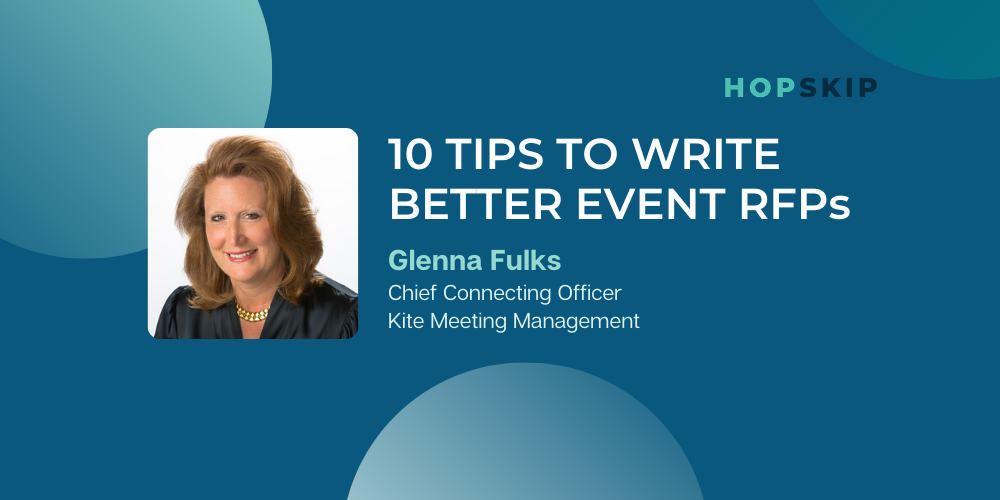10 Tips for Writing Better Event RFPs
To receive quality proposals, you need to create a well-written RFP. Learn 10 tips on how to write a great RFP that converts to top-notch proposals.

There’s a science to sourcing, and knowing the do’s and don'ts goes a long way to ensuring you receive positive responses to the RFPs you will soon be distributing by using the latest meeting planning and sourcing tool, HopSkip.
We have waited patiently for the 2020 cancelled programs to be rescheduled, and for a number of those programs, it will require finding a new venue. Some programs have likely shrunk in size due to the new spacing and distancing requirements, so in addition to finding a home for them, you will also be redesigning the seating configuration to complement the updated space and occupancy guidelines.
Make no mistake, as meetings and conferences return, hotels will be inundated with RFPs, so it's more important than ever to present the details in a clear, easy to read and understand manner. Hotels will be looking for programs that represent excellent revenue opportunities, that fill empty gaps and need dates, and the best way to guarantee your RFP is a top priority is to follow a few basic guidelines.
Hoteliers dread receiving RFPs that are vague, non-specific and leave every indication that they have a better chance of finding the proverbial needle in the haystack than being awarded the piece of business you are trying to place. Don’t put your hotel partners through the unnecessary agony of RFP Fatigue. That’s my term for planners who set RFPs into motion without providing the information that showcases your event on all its merits. Here’s a few tips:
- Provide meeting dates and especially alternative dates for consideration;
- List the breakdown of run of house rooms, suites, military discounts and staff rooms;
- Outline a general idea of the agenda and necessary function space;
- Give a reasonable estimate of the planned banquet needs;
- Offer flexibility with the meeting pattern if at all possible;
- Identify target cities and the history of where this meeting has previously occurred;
- List all the concessions at one time instead of creating a complicated negotiating process;
- Share information that may be unique or specific to this group or meeting;
- Showcase the meeting with a brief description and demographics of attendees;
- Indicate a date by which responses should be received and if possible, a target date by which a decision will be made
This is what I consider the magic ten pieces of information that allows a hotelier to present your RFP in their business review meeting. There is legitimately enough information to allow for the creation of a thoroughly detailed proposal that the hotel can weigh and consider on all its merits.
If possible, limit the distribution of your RFP to not more than eight different properties. When you cast a wide net, you will receive just as many responses and proposals that will require you to read, analyze and respond. That takes time, and more than likely, the time you don’t have.
I strongly suggest that planners do not attempt to call hotels directly, but rather, copy your national and global sales manager partners within the various chains and brands. They will be your advocate and do a lot of legwork for you. Or, utilize a 3rd party meeting planner who will source on your behalf since they have excellent relationships with all the national and global sales managers. You will get farther with your negotiations, experience a quicker response time, and enjoy much less stress than if you attempt to telephone or email hotels one at a time.
Using HopSkip allows you to do all of the above. Your needs and wants are detailed and you can still upload a physical copy of your RFP and reference your hotel partners who will receive notification of the piece of business. HopSkip is a user-friendly workflow tool that streamlines the process and creates more efficiency for the process. It’s the tool in your belt that will become your go-to resource on both the front and back end of the sourcing process. You are not sending multiple e-mails or making endless phone calls. Your personal dashboard will house previous RFPs, and the responses from hotels will be waiting in your inbox. Should the hotel have questions and require clarification, they have the ability to send you a message and await your response, all within one simple and easy-to-use sourcing tool.
The whole point of the RFP process is to search and find the venue that is the best all-around option for your event. Make it clear, concise, and communicate in the beginning all of the details that will affect your decision-making process. Hoteliers are our hospitality partners, the yin to our yang and from my experience, will go the extra distance to make your program a success.
.png?width=402&name=Glenna%20Blog%20Post%20Author%20Graphic%20(1).png)
The author is the owner of Kite Meeting Management, a premier meeting planning agency created and built with 20 years of hands-on experience as a corporate planner of internal meetings, external user-conferences, incentives, board meetings, pharmaceutical investigator programs, symposia, world congresses, and tradeshows, both domestically and internationally. Kite Meetings is also your visibility expert, working hand-in-hand to create and develop themes, designs, content, registration websites, and videos as well as your go-to to procure the perfect gifts and swag for the event. Kite Meetings is aiming higher and going farther, every single time. Visit our website at www.kitemeetings.com and allow us to reduce your stress while elevating your event to the next level of excellence.